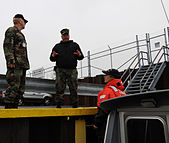A naval militia is a reserve military organization administered under the authority of a state government in the United States. It is often composed of reservists of the Navy Reserve, Marine Corps Reserve, and Coast Guard Reserve, retirees and volunteers. They are distinguishable from the U.S. Coast Guard Auxiliary which is a federally chartered civilian volunteer component of the U.S. Coast Guard and falls under the command of the Commandant of the Coast Guard through the Chief Director of the Auxiliary, and the United States Maritime Service and United States Merchant Marine, both of which are federal maritime services.
Under Title 10 of the United States Code, naval militias are treated differently from maritime state defense force units not primarily composed of reservists from the sea services. Naval militias are considered parts of the organized militia under federal law and thus members have a slightly different status.[1] Naval militias, though they are state armed forces, may receive federal supplies and use Navy or Marine Corps facilities available to Naval Reserve or Marine Corps Reserve units subject to certain restrictions.[2]
Like members of the National Guard, the Navy and Marine Reservists who constitute most of the membership in naval militias serve in a dual federal and state capacity; they operate as a component of their state's military force, and are subject to be called up and deployed by the governor of their respective states during emergencies. However, when individual sailors and marines are federalized, they are relieved from their state obligations and placed under federal control until they are released from active service.[3]
Seamen and state marines belonging to naval militias who do not hold federal status may be enlisted or commissioned into the federal sea services at the rank they are qualified for, at the discretion of the Secretary of the Navy.[4]
- ^ "10 U.S. Code § 246 - Militia: composition and classes". Legal Information Institute. Retrieved February 19, 2019.
- ^ "10 U.S. Code § 8904 - Availability of material for Naval Militia". law.cornell.edu. Retrieved January 29, 2022.
- ^ "10 U.S. Code § 8903 - Release from Militia duty upon order to active duty in reserve components". law.cornell.edu. Retrieved January 29, 2022.
- ^ "10 U.S. Code § 8902 - Appointment and enlistment in reserve components". law.cornell.edu. Retrieved January 29, 2022.




